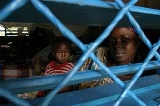
Bossangoa
Encyclopedia
Bossangoa is the capital of Ouham
, one of the 14 prefecture
s of the Central African Republic
. The town has a population of 36,478 (2003 census). It is located 303 km (189 mi) north of the country's capital, Bangui
. The Ouham River
passes through Bossangoa and on through a number of waterfalls east of the city before turning north to join the Chari River in Chad.
The Mandjia, the third most populous ethnic group in the Central African Republic, are concentrated in Bossangoa. Along with the Baya, a closely related group, the Mandjia are important historically for their resistance to invasion by various Muslim powers to the north. From 1901 to 1905 Bossangoa and the surrounding area was in rebellion against French colonial authorities. Bossangoa became a center of Protestant missionary activity during the 1920s. In 1959, the city was made the seat of the Apostolic Prefecture of Bossangoa from the Diocese of Berbérati. In 1964, it was promoted as the Diocese of Bossangoa. In June 1980 the city was the scene of clashes between police and farmers over government food policies. The next year French troops were called in to suppress rioting in the aftermath of elections.
Small local airport
(light planes). Main agricultural production: cotton
and coffee
.
Ouham
Ouham is one of the 14 prefectures of the Central African Republic. Its capital is Bossangoa.-Geography:The prefecture is in the nord-west of the Central African Republic. In the north it has a border with the Chad. In the south is the prefecture Ombella-Mpoko, in the west the prefecture...
, one of the 14 prefecture
Prefecture
A prefecture is an administrative jurisdiction or subdivision in any of various countries and within some international church structures, and in antiquity a Roman district governed by an appointed prefect.-Antiquity:...
s of the Central African Republic
Central African Republic
The Central African Republic , is a landlocked country in Central Africa. It borders Chad in the north, Sudan in the north east, South Sudan in the east, the Democratic Republic of the Congo and the Republic of the Congo in the south, and Cameroon in the west. The CAR covers a land area of about ,...
. The town has a population of 36,478 (2003 census). It is located 303 km (189 mi) north of the country's capital, Bangui
Bangui
-Law and government:Bangui is an autonomous commune of the Central African Republic. With an area of 67 km², it is by far the smallest high-level administrative division of the CAR in area but the highest in population...
. The Ouham River
Ouham River
The Ouham River is a river in Central Africa, and one of the main headwaters of the Chari River. The Ouham originates in the Central African Republic between the prefecture Nana-Mambéré and the prefecture Ouham-Pendé, crossing into Chad where it joins the Chari about 25 km north Sarh...
passes through Bossangoa and on through a number of waterfalls east of the city before turning north to join the Chari River in Chad.
The Mandjia, the third most populous ethnic group in the Central African Republic, are concentrated in Bossangoa. Along with the Baya, a closely related group, the Mandjia are important historically for their resistance to invasion by various Muslim powers to the north. From 1901 to 1905 Bossangoa and the surrounding area was in rebellion against French colonial authorities. Bossangoa became a center of Protestant missionary activity during the 1920s. In 1959, the city was made the seat of the Apostolic Prefecture of Bossangoa from the Diocese of Berbérati. In 1964, it was promoted as the Diocese of Bossangoa. In June 1980 the city was the scene of clashes between police and farmers over government food policies. The next year French troops were called in to suppress rioting in the aftermath of elections.
Small local airport
Airport
An airport is a location where aircraft such as fixed-wing aircraft, helicopters, and blimps take off and land. Aircraft may be stored or maintained at an airport...
(light planes). Main agricultural production: cotton
Cotton
Cotton is a soft, fluffy staple fiber that grows in a boll, or protective capsule, around the seeds of cotton plants of the genus Gossypium. The fiber is almost pure cellulose. The botanical purpose of cotton fiber is to aid in seed dispersal....
and coffee
Coffee
Coffee is a brewed beverage with a dark,init brooo acidic flavor prepared from the roasted seeds of the coffee plant, colloquially called coffee beans. The beans are found in coffee cherries, which grow on trees cultivated in over 70 countries, primarily in equatorial Latin America, Southeast Asia,...
.

